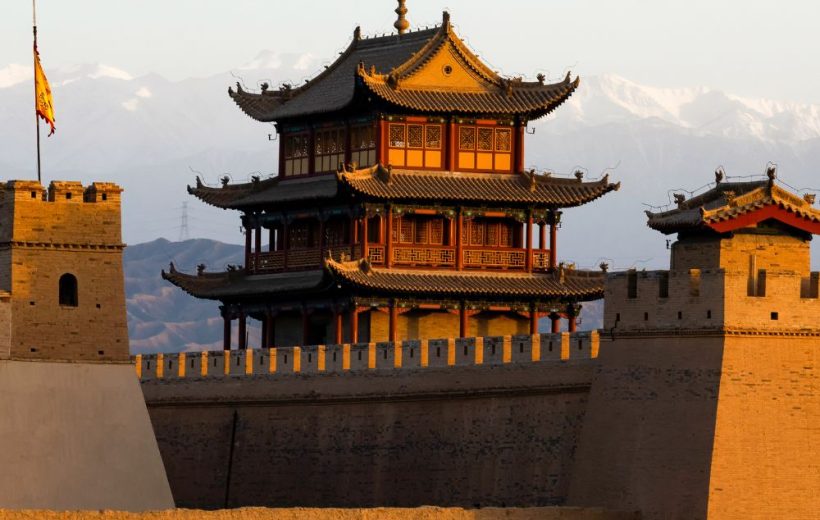About
Gansu, located in northwest China, is a treasure trove of history, culture, and stunning natural landscapes. As a key stop along the ancient Silk Road, Gansu is home to iconic destinations like the Mogao Caves in Dunhuang, famous for their exquisite Buddhist art, and the Jiayuguan Pass, the westernmost end of the Great Wall. The province offers diverse experiences, from exploring the colorful Zhangye Danxia Landform to visiting the ancient city of Wuwei and its Tiantishan Grottoes.
Travelers can enjoy rich cultural heritage, awe-inspiring deserts, mountains, and rivers, making Gansu a perfect blend of history and adventure. Whether you’re hiking in the Qilian Mountains or tracing the footsteps of ancient traders, Gansu is a must-see destination for those seeking to explore China’s Silk Road legacy.

Things to Do
· The Mogao Caves: also known as the Dunhuang Caves or Thousand Buddha Grottoes, are a series of ancient Buddhist cave temples located near Dunhuang in China’s Gansu province. Dating back to the 4th century AD, the caves were an important spiritual and cultural center along the Silk Road, where traders, monks, and artists exchanged ideas and goods.
These caves contain some of the world’s most stunning examples of Buddhist art, with thousands of murals, sculptures, and manuscripts that reflect a unique blend of Indian, Persian, and Chinese influences. The site consists of nearly 500 caves carved into the cliffs, each filled with statues of Buddhas, Bodhisattvas, and other religious figures. It is now a UNESCO World Heritage site, showcasing over a millennium of artistic and cultural development in Asia.
· Zhangye National Geopark: is located in China’s Gansu province, famous for its vibrant, rainbow-colored rock formations known as the Danxia landforms. These stunning, multicolored layers of rock were formed by millions of years of sedimentation and tectonic shifts. The park spans over 500 square kilometers and offers dramatic, surreal landscapes that attract photographers and nature lovers. It’s one of China’s most striking natural wonders, showcasing a unique blend of geology and breathtaking beauty.
· The Singing Sand Dunes: located near Dunhuang in China’s Gobi Desert, are famous for the humming or “singing” sounds they produce when the sand shifts. These massive dunes, reaching heights of over 250 meters, are a popular attraction, where visitors can hear the distinctive sound caused by the friction of sand grains as they slide down the slopes. The area also offers stunning desert views and is home to the Crescent Lake oasis, creating a striking contrast between the dry dunes and lush greenery.
· Jiayuguan: is a historic fortress located at the western end of the Great Wall of China in Gansu province. Built in the 14th century during the Ming Dynasty, it was a key military outpost and the last major fortification along the Great Wall, marking the boundary between Chinese civilization and the desert beyond. Known as the “First and Greatest Pass Under Heaven,” Jiayuguan was a crucial defense point and a gateway for travelers and traders along the Silk Road. Its impressive walls, towers, and gate provide a glimpse into China’s ancient military history and strategic importance.
· The Tiantishan Grottoes: located near Wuwei in Gansu province, China, are ancient Buddhist cave temples carved into a mountainside. Dating back to the 5th century during the Northern Liang period, these caves house intricate Buddhist statues and murals, reflecting the early spread of Buddhism in China. The site is smaller and less known than other grottoes like Mogao, but it holds significant historical and cultural value. The name “Tiantishan” means “Heavenly Ladder Mountain,” referring to the steep climb up to the caves, which overlook the scenic Yellow River valley.
· The Mati Temple and Grottoes: near Zhangye in Gansu province, are ancient Buddhist cave temples carved into cliffs. Dating back to the 4th century, the site blends Tibetan and Han Chinese art. Named after a legend of a sacred horse’s hoof print, the grottoes feature intricate carvings and Buddha statues. Set against a backdrop of mountains and greenery, it’s a spiritual and scenic highlight on the Silk Road.
· Pingshanhu Grand Canyon: located near Zhangye in Gansu province, China, is a stunning natural canyon known for its towering red rock formations and deep gorges. Carved by water and wind over millions of years, the canyon stretches for over 14 kilometers and reaches depths of 100 meters. Its dramatic landscapes of jagged cliffs, narrow ravines, and vibrant colors make it a popular destination for hikers and photographers. Often compared to the Grand Canyon in the U.S., Pingshanhu offers breathtaking views and a sense of adventure in a less-traveled region of China.
· The Yulin Caves: located in Gansu province near the Mogao Caves, are a lesser-known but important collection of Buddhist cave temples. Dating back to the Tang Dynasty, these caves feature stunning murals and sculptures similar to those in Mogao, reflecting a blend of Indian, Tibetan, and Chinese artistic influences. With 42 caves in total, Yulin Caves showcase intricate Buddhist art, including vivid depictions of religious stories, deities, and Bodhisattvas. Though smaller in scale, the caves offer a more intimate and serene experience, preserving valuable insights into ancient Silk Road culture.
· The Giant Buddha Temple: is home to a massive reclining Buddha statue that measures about 34 meters (110 feet) long. Dating back to the Han Dynasty, the temple complex includes a variety of halls and smaller statues, showcasing a blend of Buddhist art and architecture. The reclining Buddha, which symbolizes the moment of enlightenment, is intricately carved and adorned with beautiful murals. The temple is not only a significant religious site but also a cultural landmark, attracting visitors interested in both spirituality and history.
· The Kumarajiva Temple: is dedicated to the esteemed Buddhist monk and translator Kumarajiva, known for his pivotal role in translating key Buddhist texts into Chinese. The temple features traditional Chinese architecture and houses various statues and murals that honor his legacy. It serves as a significant pilgrimage site for Buddhists and a cultural landmark, reflecting the rich history of Buddhism in the region. The temple also offers visitors insights into the teachings and impact of Kumarajiva on Chinese Buddhism.

Must-try Cuisines
· Shouzhua Yangrou: A.K.A. Boiled mutton is a traditional dish from Gansu province, particularly popular in the Zhangye and Wuwei regions. The name translates to “hand-pulled mutton,” highlighting the unique preparation method. The dish features tender, boiled mutton that is expertly pulled apart by hand, often served with a savory dipping sauce made from garlic, chili oil, and spices. It’s typically accompanied by flatbreads or noodles, making for a hearty and flavorful meal. Shouzhua Yangrou is not only a staple in local cuisine but also a reflection of Gansu’s rich culinary heritage.
· Lanzhou beef noodle soup: is a signature dish from Lanzhou, the capital of Gansu province. Known for its hand-pulled noodles, the soup features a savory broth made from slow-cooked beef bones and aromatic spices. Topped with slices of tender beef, fresh cilantro, green onions, and often a hint of chili oil, this dish is both flavorful and comforting. The noodles are typically served in a clear broth, allowing the rich flavors to shine through. Lanzhou beef noodle soup is a beloved staple in Chinese cuisine and has gained popularity worldwide for its delicious taste and unique preparation methods.
· Niangpizi: a traditional dish from Gansu province, particularly popular in Lanzhou. It consists of a thin, savory pancake made from a batter of flour, water, and sometimes eggs, which is then filled with a variety of ingredients like minced meat, vegetables, and spices. The pancake is rolled up and can be either steamed or pan-fried, resulting in a soft, flavorful roll. Niangpizi is often enjoyed as a street food snack or a quick meal, showcasing the region’s culinary heritage and versatility in using simple ingredients to create delicious dishes.
· Jiayuguan BBQ: refers to the vibrant barbecue scene in Jiayuguan, Gansu province. This culinary experience features a variety of skewered meats, including lamb, beef, and chicken, marinated with spices and grilled over open flames. The skewers are often seasoned with cumin, chili, and sesame, giving them a rich flavor. Jiayuguan’s BBQ is typically enjoyed in outdoor settings, where locals and visitors gather to savor the smoky, grilled delicacies. Accompanied by fresh vegetables and dipping sauces, this street food staple is a must-try for anyone exploring the region’s cuisine.
· Dunhuang donkey meat yellow noodles: one of the most popular local dishes in Dunhuang, Gansu province. The dish features hand-pulled yellow wheat noodles served with tender, marinated donkey meat, which is known for its rich flavor and unique texture. The noodles are typically cooked until al dente and then topped with slices of the savory donkey meat, often accompanied by a flavorful broth and garnished with herbs and spices. This hearty meal reflects the region’s culinary traditions and showcases the use of local ingredients, making it a must-try for visitors to Dunhuang.
· Milk and eggs in glutinous rice wine: one of the traditional dishes from Gansu province, often enjoyed as a comforting and nutritious treat. This dish typically combines glutinous rice wine, which is slightly sweet and has a fragrant aroma, with milk and eggs. The ingredients are gently simmered together, creating a creamy, warm concoction that is both soothing and satisfying. It is commonly served as a dessert or snack and is valued for its health benefits, especially during colder months. The combination of flavors highlights the unique culinary heritage of Gansu and showcases the region’s use of local ingredients.

Travel Tips
· Best Time to Visit: The ideal months are May to October when the weather is mild and the landscapes are vibrant.
· Pack Accordingly: Gansu has varied climates; bring layers for cooler evenings and sun protection for daytime excursions.
· Local Cuisine: Don’t miss trying local dishes like Lanzhou beef noodles and savory dumplings. Visit local markets for authentic flavors.
· Cultural Etiquette: Be respectful of local customs, especially in Tibetan areas. Learn a few basic phrases in Mandarin or Tibetan to connect with locals.
· Transportation: Consider using trains or buses for longer distances, as they provide a chance to enjoy the scenic landscapes.
· Stay Hydrated: Drink plenty of water, especially in higher altitudes like Qinghai Lake, to avoid altitude sickness.
· Plan for Cash: While mobile payments like WeChat Pay and Alipay are common, it’s good to have some cash on hand for smaller vendors.
· Connectivity: Internet access may vary; consider getting a local SIM card for better coverage.
· Time for Exploration: Allow extra time for visits to historical sites, as many have extensive grounds worth exploring.
· Safety: Gansu is generally safe, but always take standard precautions and keep an eye on personal belongings.




